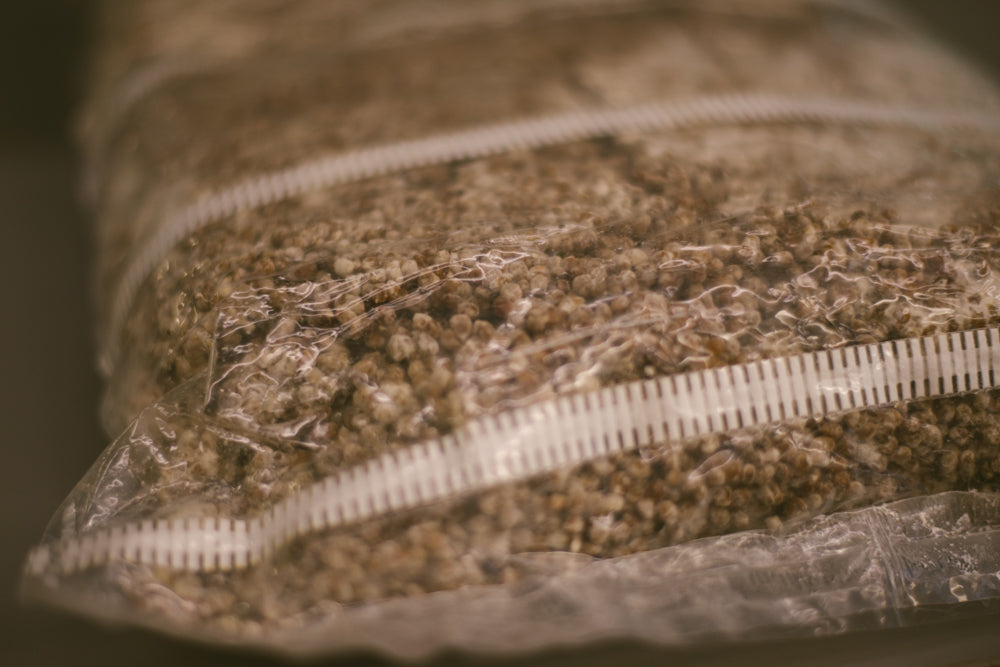Today we are discussing some of the best grain for mushroom spawn creation and the mushroom strains that thrive as grain spawn
People often wonder about the best grain for mushroom spawn. Grain is great because it allows for advantageous spawn. It is also a great option for supplementing other growing mediums.
Grain spawn gives one major advantage by supplying a pre-colonized Nitrogen source to the substrate. This can help to increase yields of low nitrogen substrates like straw or paper waste. If you peruse the internet for information on grain spawn, as we do frequently, you will likely see that rye is considered to be the gold standard in growing mushrooms on grain. However, there are some that believe millet is the best grain for mushroom spawn. The reason: Smaller grains like millet are preferred to larger grains like rye or wheat as they allow for more inoculation points from the same amount of inoculum. One pound of rye spawn may have about 200 particles for the mycelium to leap off from while millet will have closer to 500. By using millet, a smaller grain, the mycelium will spread more evenly and abundantly through the substrate. Similarly, sawdust can be better than larger grains because of the small particle size.
The use of grain in growing mushrooms
Grain is used as a high-nutrient medium for rapid mycelial expansion. It is typically the step after mycelial growth on agar medium. Grain is too expensive and too high in nutrients for bulk substrate fruiting, but can be a good supplement to the sawdust or wood pellet base. It works well to boost yields by inoculating straw with large amounts of grain spawn. Grain also needs to be treated using pressurized steam and inoculated in lab conditions. It is very easy to get contamination on grain, so this is not a beginner substrate.
Supplementing sawdust with the use of grain
Grain spawn is typically a lower generation and has a higher nutrient profile. This makes grain spawn a good option when the substrate will be further expanded or if you want to add additional nutrients into the substrate. For example, if inoculating grain with the intent of then adding it to a sawdust fruiting block, you would want to use a first or second generation bag of grain spawn. If you were inoculating straw or supplemented sawdust, using grain could be a good option for adding additional nutrients into the substrate. One advantage of using sawdust in this case is that the mycelium is already familiar with eating sawdust, so leaping off might be faster off sawdust than grain.
Understanding the “generations” of grain spawn
The generations of spawn are very straight forward. The first substrate inoculated from a petri plate is usually grain and called Generation 1. This is then expanded 8-10x into more grain which is Generation 2 grain. From here, farmers usually either go to Generation 3 grain or sawdust. Most growers do not perform transfers beyond four generations for fear that the strain losing vigor in fruiting -- a phenomenon called strain senescence.
Types and strains of mushrooms that grow well on grain
Grain spawn is a good option for indoor growing. We’re going to take a look into various mushrooms and strains of those mushrooms to use for yielding tasty mushrooms indoors, at home or your commercial mushroom space.
For shiitake lovers there is the Shiitake Grain Spawn LE 46. This strain is known as the workhorse for commercial mushroom farmers who use logs. If you are looking for big yields from a strain that colonizes quickly, then this is a great option for you. The fruited mushrooms themselves are beautiful, presenting a dark cap with white ornamentation of its edges. If you are using hardwood logs for cultivation then this is another great reason to use this strain. This mushroom loves hardwood, fruits at a wide range of temperatures, and responds well to shocking. A log farmer’s dream! You can buy your own Shiitake Grain Spawn LE 46 here now.
Next we will consider the Blue Oyster Grain Spawn 3015. Do you want to try your hand at growing oyster mushrooms indoors on straw, wood, or used coffee grounds? If you do and you want great yields, then this is the strain to try. Oyster mushrooms are a perfect introduction to mushroom growing for beginners because they are one of the easier types of mushrooms to grow. Fortunately, they are also delicious and pleasant to look at as they fruit. This blue oyster grain spawn strain produces large fruiting bodies, has a fast spawn run, and yields mushrooms with a beautiful blue color that is vibrant when young. This mushroom fruits in a wide range of temperatures between 55 and 75 degrees Fahrenheit.
You can buy your own Blue Oyster Grain Spawn 3015 here now. Try these strains and any other of our grain spawn options and let us know what you think the best grain for mushroom spawn is.

